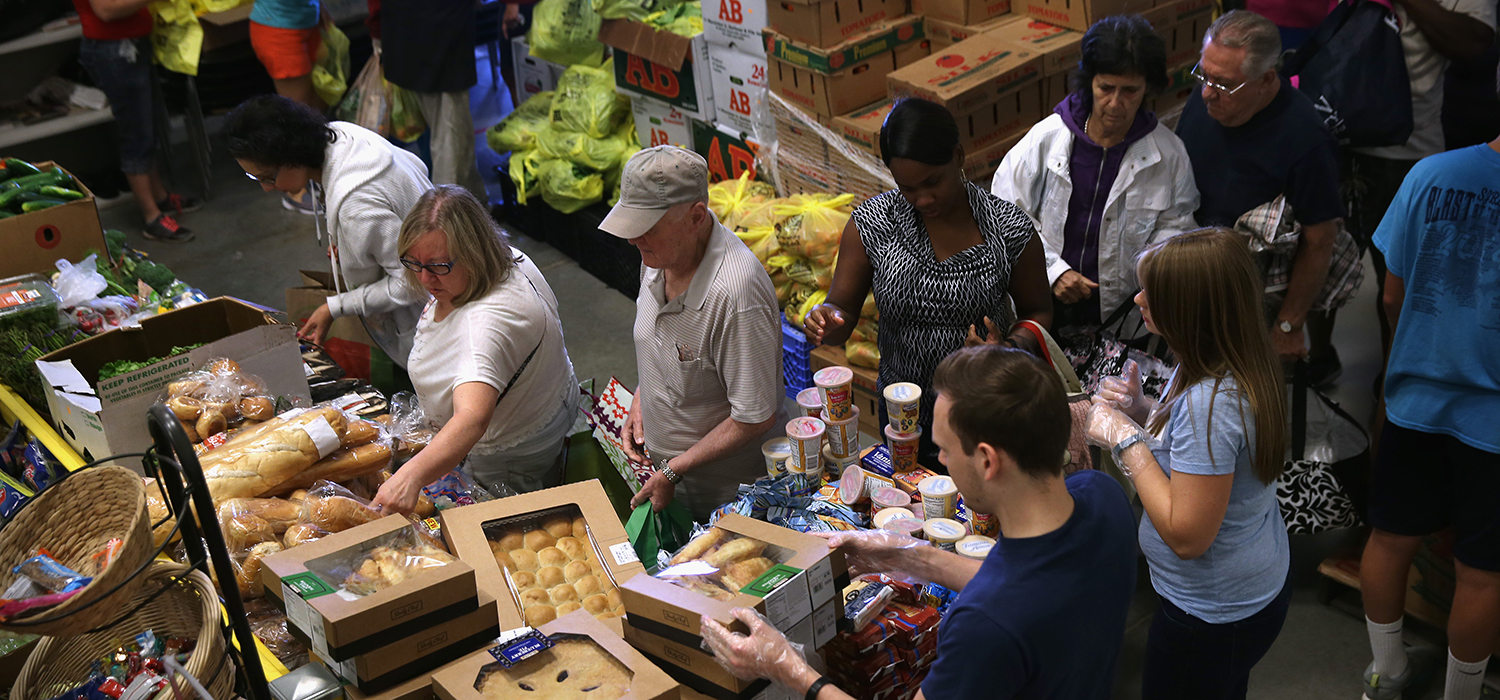
<p>EGG HARBOR, NJ: Low-income residents select fresh bread and produce at the Community Food Bank of New Jersey on August 28, 2015. The food bank has seen an 11 percent increase in food distribution in Atlantic County since four of Atlantic City's major casinos closed in 2014, laying of 8,000 people. The closures brought Atlantic City's unemployment rate to more than 11 percent, double the national average. The mass unemployment has produced the highest foreclosure rate of any metropolitan US area, with 1 out of 113 homes now in foreclosure in Atlantic County. (Photo by John Moore/Getty Images)</p>
Food banks face the monumental task of serving millions of pounds of fresh fruit, vegetables, meat, dairy, and shelf-stable food to families in need each month.
But people experiencing food insecurity often face other hardships, such as housing instability and financial insecurity. Many food banks provide programs that offer additional wraparound services to support broader stability in people’s lives, but developing these new services can come with new challenges.
Urban’s new report explores how food banks and other organizations that serve families with low incomes can use lessons from housing, financial security, workforce development, and case management interventions to increase the impact of their services.
To complement this work, we talked with four Feeding America network member food banks about their perspectives on using research to help them better serve families in need. We learned that as food banks start offering more wraparound services, they may face challenges in connecting with hard-to-reach people, collecting data, and building sustained partnerships.
1. People with greater needs may face barriers to engaging in programs
Food banks provide support to people who may need many services to help put them on a path toward stability. But engaging people in need in new programs can be difficult if they move frequently or if they’re focused on other challenges, such as a sick family member or a job loss.
In these cases, they don’t have as much time to focus on program requirements, like regular coaching sessions or job training. If the families originally targeted for programs face significant barriers to participation, food banks might struggle to reach them and may see higher attrition rates. As a result, they may have difficulty determining a program’s effectiveness.
2. Data collection can be a challenge
Families who move frequently or are otherwise less stable can be more difficult to track and collect follow-up data from, making it challenging to determine a program’s impact. Without postprogram data on participants, it can be difficult for food banks to communicate impacts to funders, community stakeholders, and other potential participants.
Kurt Reiber, CEO and president of the Freestore Foodbank, told us how his organization has creatively leveraged social media to keep in touch with program participants who move frequently, which allows program administrators to reach participants and hear about how things are going after their workforce programs, Cincinnati COOKS! and LIFT the TriState, end. This, among other strategies, can be an innovative way to collect postprogram data and better understand program impacts.
3. Partnerships are critical but complex
Programs that offer wraparound services may be built in partnership with other agencies and organizations, requiring food banks to build a framework for working with partners on data-sharing agreements and privacy.
Data-sharing and privacy agreements are just one part of building sustained partnerships. These partnerships can include those who have made investments in shared programming, those who share data on participants, and those who have come together to be thought partners in program development.
Nicole Lander, chief impact officer at the Houston Food Bank, said that as food bank leaders developed the Food for Change program, they continually modified how they review grant applications for partnerships to improve partner engagement. This thoughtful work around defining and supporting partnership development was described as challenging by the food banks we spoke with.
Reiber added that collaborative partnerships are critical when an organization launches a program that goes beyond its core mission. An organization must determine what programs it has the core competencies to “own or lead” versus what it should “participate in or support,” to avoid the potential for “mission creep.”
Engaging partners is critical to offering wraparound services people need to build stability, but some challenges can emerge at the organizational level. Boards or other leadership may be slow to adopt perspectives that facilitate broader stability work because they are unsure of the appropriate role of food banks. Food banks have been working to navigate this space, identifying a path forward and ways to engage that fit with their organizational visions and capacity.
Leveraging evidence to build new programs
Despite these potential roadblocks, the food banks we spoke with had clear plans for moving forward in developing broader stability programs. They aim to continue iterating programs and exploring new ways of delivering services to clients. Once the right programs are identified, they plan to partner with funders to establish sustainable funding and start tracking program outcomes with new, potentially standardized metrics to capture program impact.
Although food banks have experienced challenges in making evidence-based programs a reality in their communities, they have a clear commitment to meaningfully innovate and support greater stability among the families they serve.
Let’s build a future where everyone, everywhere has the opportunity and power to thrive
Urban is more determined than ever to partner with changemakers to unlock opportunities that give people across the country a fair shot at reaching their fullest potential. Invest in Urban to power this type of work.